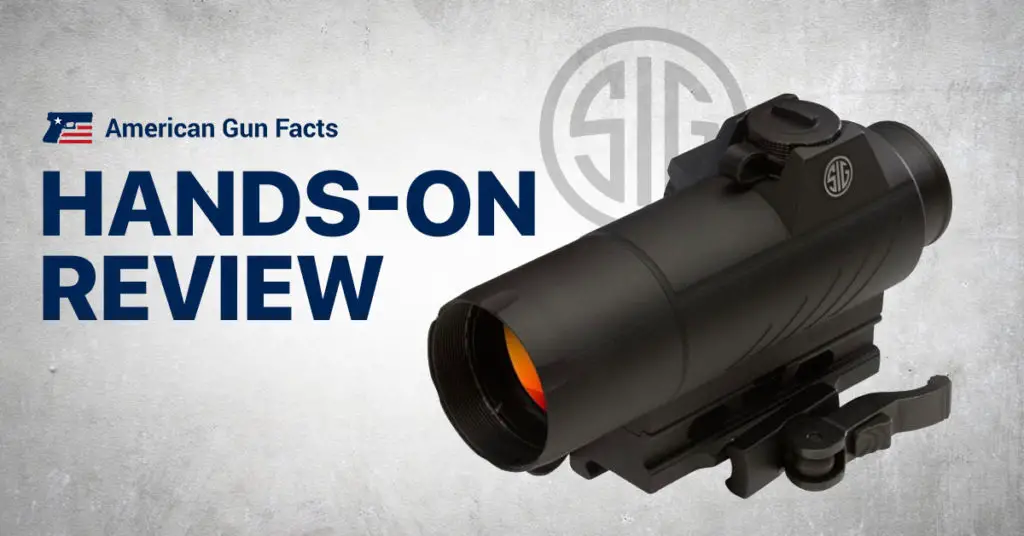Full disclosure, I am a precision rifle guy. I love to shoot, and I love to put a bullet hole on paper and then try to shoot the bullet hole. If a firearm is not accurate, it doesn’t last long in my safe. So, it wouldn’t surprise most people that even on shorter barreled AR platforms, I have always had a higher-powered optic with great glass on top. The older I get, the more my aging eyes prefer the clear glass and extra magnification. So, when my wife told me she wanted to swap out a fantastic optic like a Vortex Viper HST for a red dot, I couldn’t roll my eyes hard enough, fast enough.
Her AR, a Rock River LAR15, a lightweight, insanely accurate 5.56 with an adjustable stock is happy with either type of optic. It is equally at home as a predator rifle, a short-range varmint rifle, patrol, or home defense rifle. So, in theory, while I was of course losing a back up rifle for prairie dogs because let’s be honest, a 2 MOA red dot is going to mostly cover a prairie dog at any distance at all, but it would still be a great close quarters coyote set up, and more importantly, since it is after all her rifle, throwing a red dot in there made it far easier for her to shoot with both eyes open, and acquire targets with insane speed, something she struggled to do with a high powered, narrow field of view precision rifle optic.
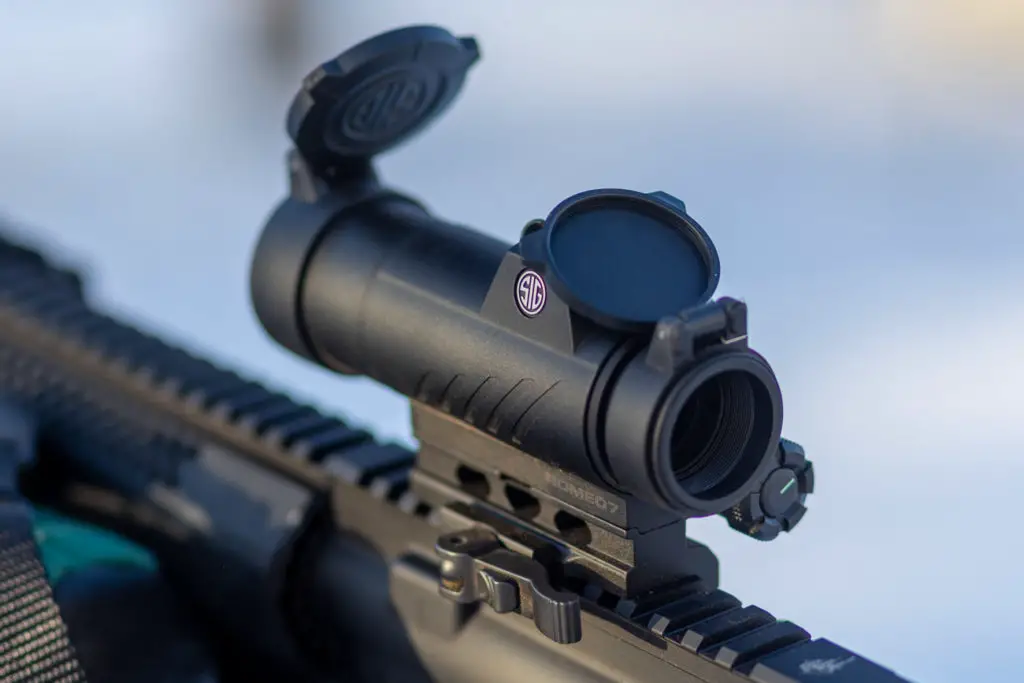
Since I would likely shoot the rifle as much as she would, I wanted to make certain we would both be happy with whatever optic was chosen. While this sounds like an easy task, being colorblind I had my doubts on how easily I could or would pick up the dot depending on the background. That said, in the end it is her rifle, so I started reading reviews and comparing different options and happily “settled” on the Sig Sauer Romeo 7. While there were several factors that pushed me that direction, a few things stood out that were impossible to ignore, and after purchasing quite some time ago and having had time to literally BEAT this optic to try and make it fail so we could go back to my kind of optics, it is still on the rifle, and for good reason; it is reliable and accurate.
Let’s talk about features and then get into the “good and the bad” of the optic. The good is really good, and the bad is not really an issue, but rather something that could have been done differently. More on that coming up.
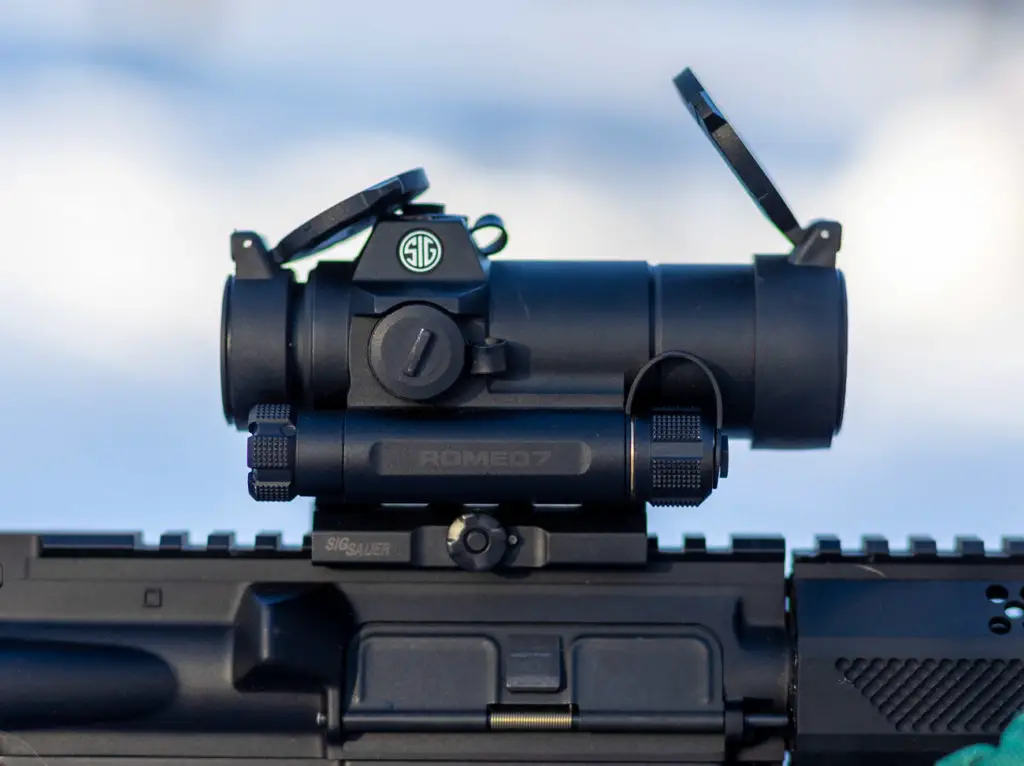
Check Price at:
Specs
| Objective Lens Diameter | 30 mm |
| Adjustment Increments | 0.5 MOA |
| Length | 4.7 in |
| Width | 2 in |
| Height | 2.2 in |
| Weight | 12.5 oz |
| Reticle Size | 2 MOA |
The weight of the Romeo 7 is, by most reviewer standards, heavy. At 12.5 ounces, it is likely to be the heaviest red dot you would consider. Is that really an issue thought? Do you really notice an ounce here or there by comparison? No. Let’s be honest, no one could tell the difference if they were blindfolded, and yet they would appreciate the build quality, so it really is a non-issue.
Part of the weight comes from that 30mm tube and some of it comes from the overall length and the fact that it is in some solid, rugged aircraft aluminum. I have read and watched reviews where the weight was lamented but, if weight was really an issue, swapping out to a smaller magazine alone would more than make up the difference.
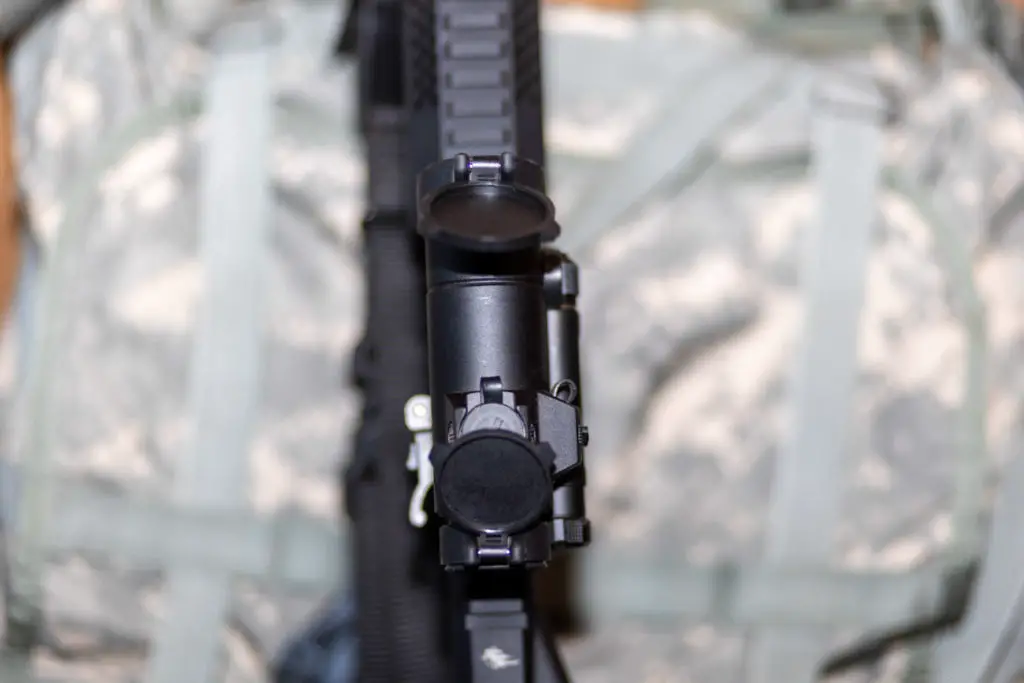
One review complaining on weight showed a rifle with a flashlight mounted and a bipod as well, with a rifle the shooter was probably not likely to shoot over 25 meters with… so, to each their own, but I have a hard time hearing about this optic weighing 2 or 3 ounces more than a competitor’s option when there are so many other factors involved.
Romeo 7 Features
Battery Life
On paper, the first thing that stands out with the Sig Romeo 7 optic is the battery life. At 62,500 hours on a medium setting, you are likely to be on your second truck before you replace the battery. Battery life is insanely good in part to a fantastic piece of technology Sig terms as “Motac” and it is awesome. The Romeo hibernates while not in use and powers up with the slightest bit of motion on whatever setting you had it on when you put it away. This extends the single AA battery life beyond what anyone, and I mean anyone could expect.
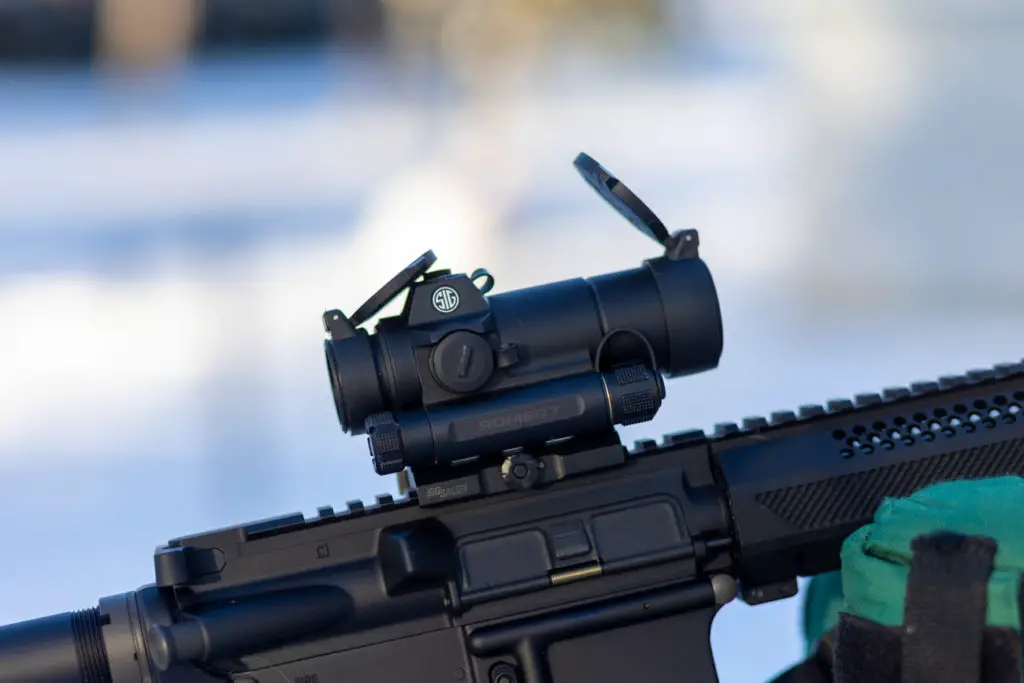
On the off chance you need to replace the battery, it is simple, requires no tools, and the optic doesn’t need to be removed to gain access to the battery tube. Unscrew and replace, and then do it again when you pay off the loan on your truck. Literally. The battery life is longer than what a loan on a new truck is!
30mm Tube
The 1x design is built on a rather large 30mm tube. While many red dot optics sit inside a 20mm tube, the Romeo 7 is a bit larger and is housed in an anodized aluminum tube that is often described as “robust.” This tube size allows for an incredible 220 MOA of elevation adjustment. Would you ever have reason for that? Not a chance.
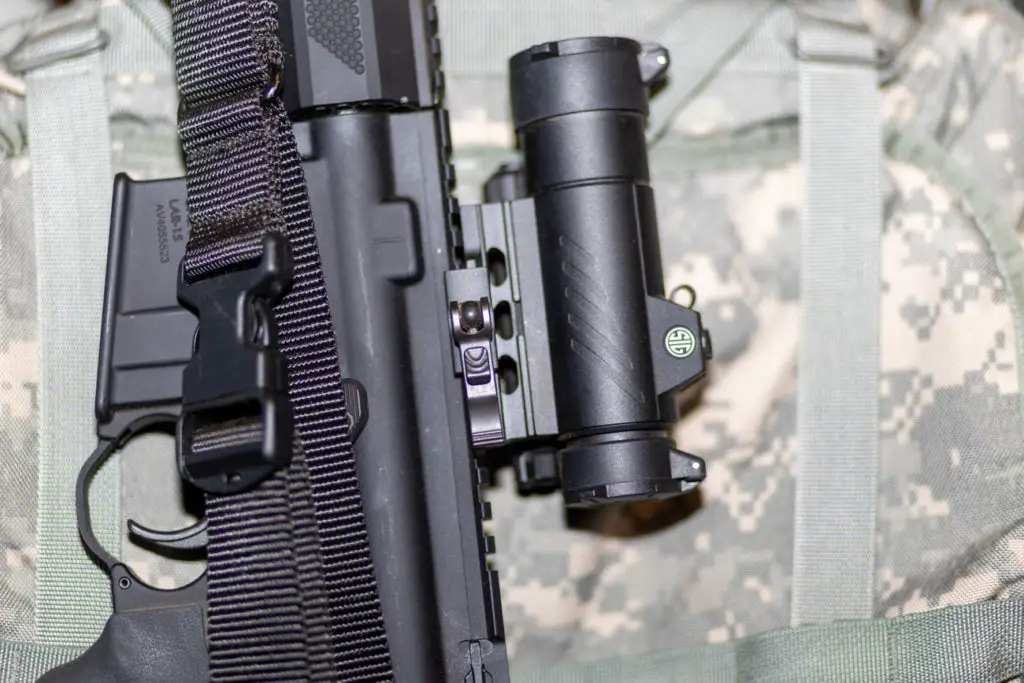
Glass Quality
Being a professional photographer, the first thing I notice in any optic of any brand or style is the quality of the glass. What many people do not notice, is edge to edge clarity, but I assure you it is something I do not overlook. In this case, the Romeo 7 glass sits well back from each end of the optic that helps protect it from dirt, scratches, and water from brushing against wet foliage or even light rain.
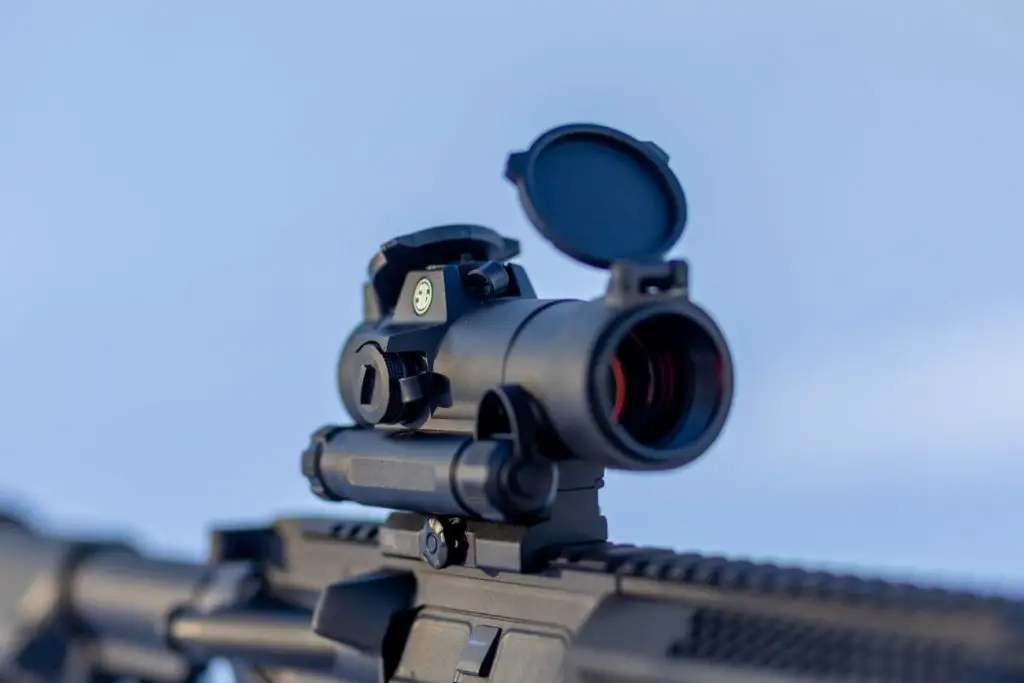
Waterproof to a meter, it would be fine getting wet, but let’s be honest, it is never a good idea to push the issue when you don’t have to but nice to know you are ok either way. What can be a big deal though, living in a state like Minnesota, and hunting in temperatures that can only be described as miserable, but often described as ‘life threatening” is fogging. Going from -30 to a 60 or more above zero truck, and then back to -30 can cause issues. To date I have had none, except of course the outside of the glass, and that will happen with any moisture and drastic heat difference.
The coated lens is LD or low dispersion glass and that helps with both clarity and light transmission as well as dot brightness. A 30mm tube doesn’t hurt with this either if we are keeping score. In my use and testing of the optic, the edge-to-edge clarity had no distortion issues and does well in low light situations.
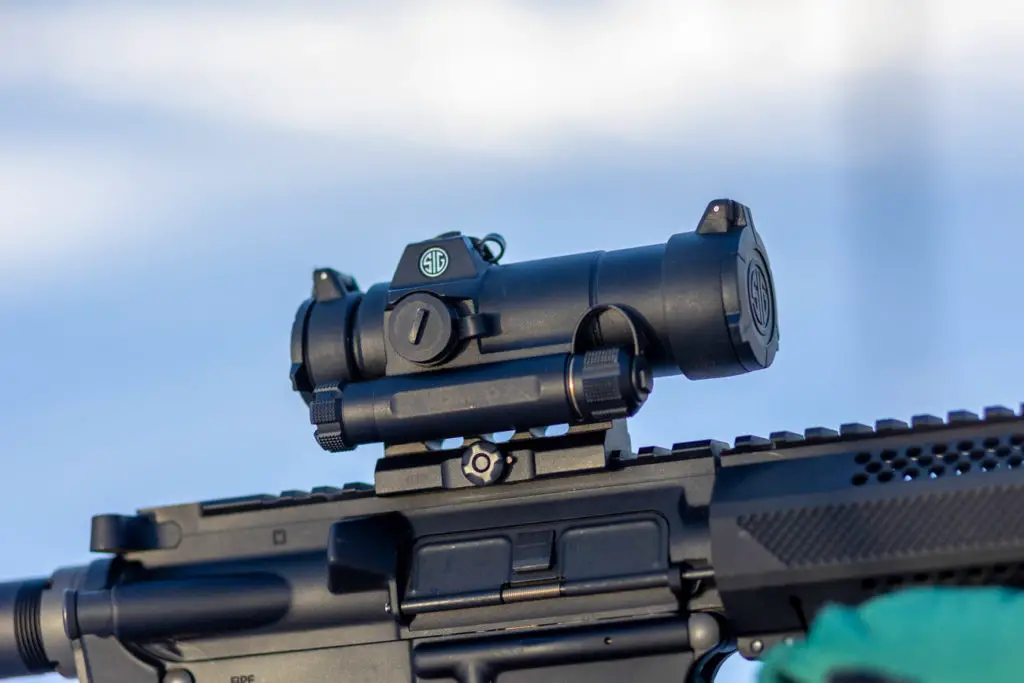
Reticle & Illumination
The Sig Romeo 7 dot itself is 2 MOA and on paper that sounds huge, and it is, but I was surprised at how precise the rifle could still be shot at distance. Is it going to punch holes inside of holes at 100 meters? No, of course not. But no red dot will. That is not their design or function. This was designed for rapid close quarter engagements of medium to larger targets. In this realm, it is epically good.
There are 9 daylight illumination settings and 2-night vision settings, and the mount is made to be able to add a magnifier or night vision. For a precision optic guy like me, a .5 MOA adjustment sounded awful, but the reality is with a 2 MOA dot, even replicating the difference when you cannot precisely determine where that 2 MOA dot is on a 1-inch square is obviously impossible. It was surprising just how tight and repeatable you could be with this set up however, and target acquisition is all but instant.
Mounting
The Sig Sauer Romeo 7 also comes with 2 mounts, a standard and a QD mount for mounting. Though I have read reviews where the QD had to be retightened, that has not been the case for me. For as easy as the QD is to mount and use, I will stick with it. Perhaps it is the lighter recoil of the AR platform. I don’t know, but I do know that even with me abusing, and literally trying to make the optic fail, it hasn’t come loose, lost zero, or frankly even become scuffed up.
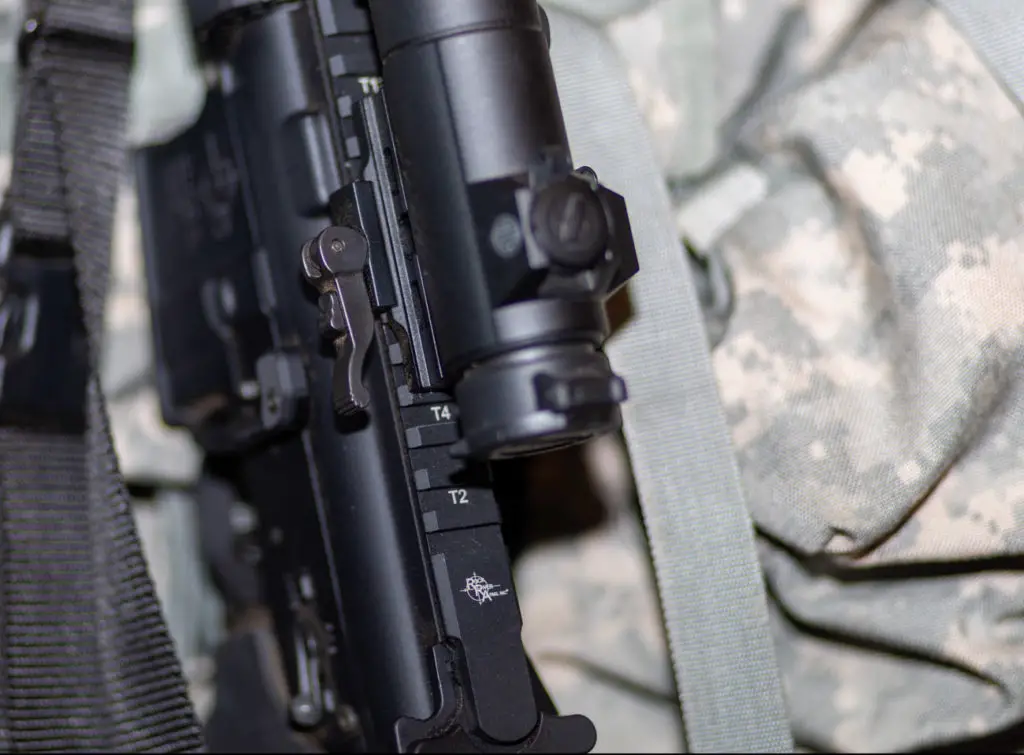
Parallax
Parallax on the Romeo 7 is described as ultra-low. What users will find with it, is no matter what your cheek weld is, it doesn’t change the dot and point of impact. You can be inconsistent in your weld, something that can happen when moving with the gun mounted or transitioning and still make accurate impacts.
Those are the basic features and details with a little personal experience thrown into the mix. Let’s talk about the good and the bad as promised.
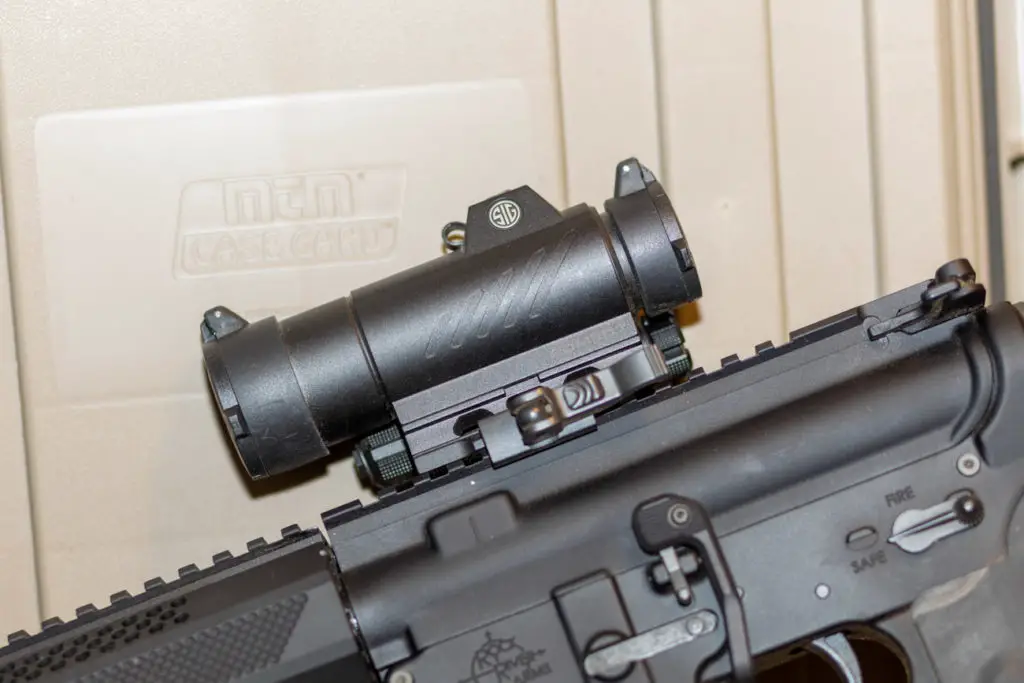
Testing Out the Romeo 7
Being color blind, I was concerned with picking up the dot on certain colored backgrounds and in certain light conditions with the Sig Romeo 7. I have no doubt that someone with normal color vision would have no issues at any level of brightness. I have found personally that cranking the level to a medium setting (finger adjustable) has made it so there are no issues, even for me. It is bright and easy to identify no matter what color background it is against. I have tried it mixed against colors that frustrate me typically and as long as it is on a medium level brightness setting, it just hasn’t been the issue I thought it would be.
I will say this, on the brighter settings, the dot can appear to flare a little. It isn’t a problem or even a distraction, but rather an observation. When I have noticed this, dialing down one level has cured that issue. Illumination adjustments are found on the battery tube, and facing the shooter, and fingertip adjustable, so changing it on the fly is both easy and precise.
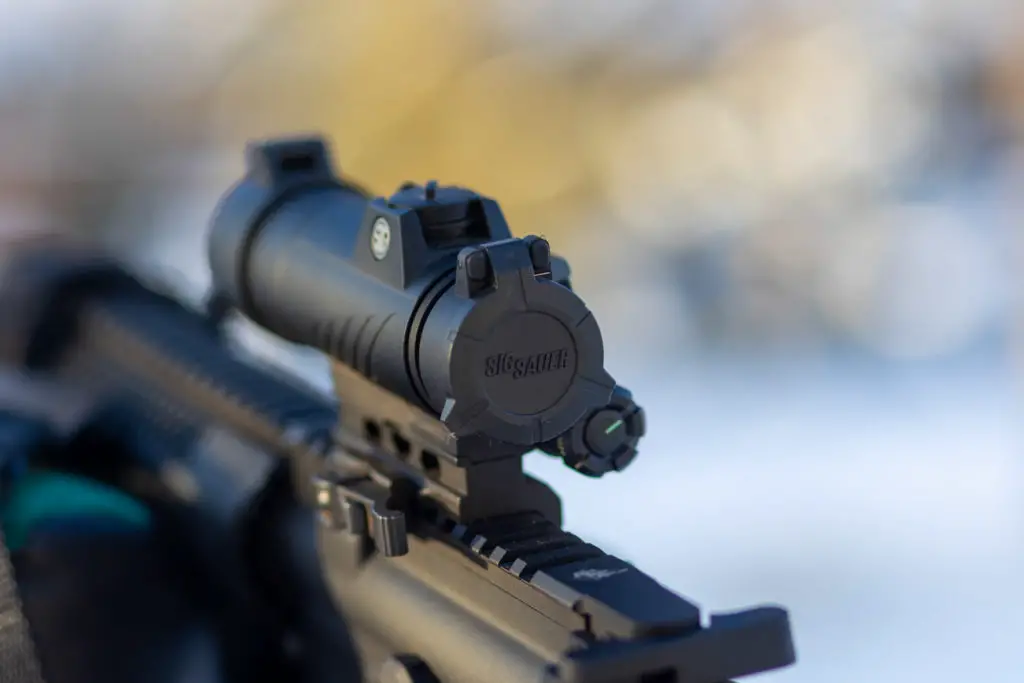
The adjustment dial of the Sig Romeo 7 has a palpable feel, and a large white line shows you where you are on the scale. Either way, if you mount the rifle and find it needing adjustment, it is easy to adjust even with gloves on. That battery tube by the way, houses a single AA battery. Thankfully Sig was smart enough to make this a “normal” battery and not a difficult to find battery and this can be a life saver on a trip in rural America on the off chance that battery finally gives up the ship after 62,000 hours and you didn’t take the 30 seconds and the cheap fix of replacing it when you could have.
As a hunter and a competitive shooter, I have shot with both eyes open for years. With rare exception for extreme long distance and aging eyes, I may squint my off eye, but rarely do I ever need or want to close it. This optic makes it easy to shoot with both eyes open, and that of course means faster secondary target or threat acquiring with no loss of accuracy. For a beginner shooter this would be a game changer. For a seasoned shooter, it is just matter of fact. Being able to have a massive amount of eye relief is just a bonus and a nice change of pace over massive zoom precision optics that have a very shallow eye box as well.
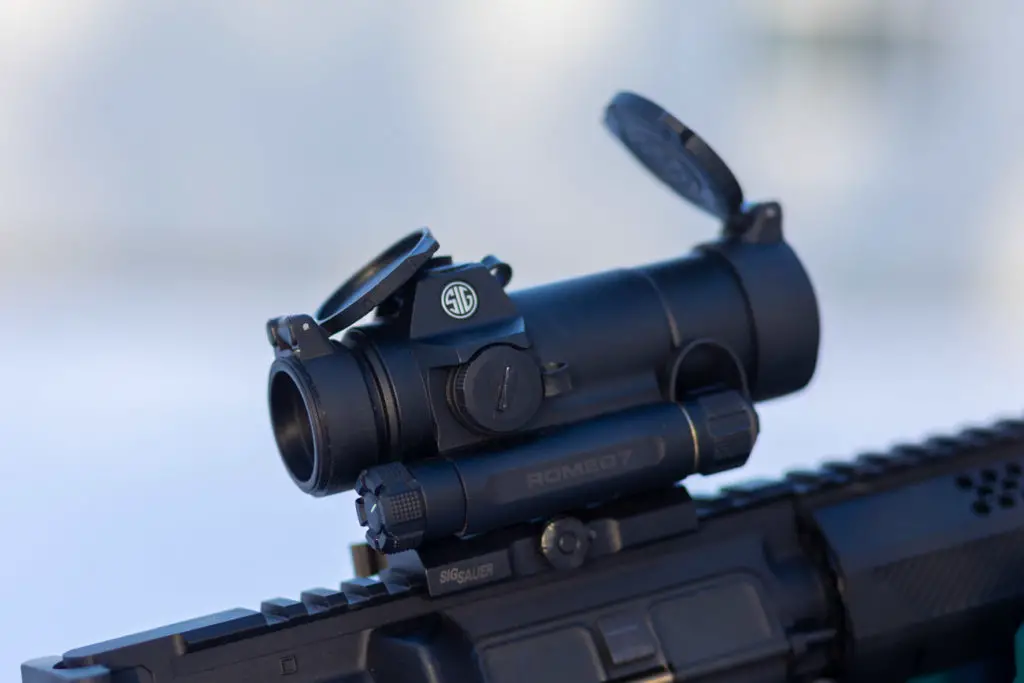
While I have never measured a group with the Romeo 7, I found the accuracy to be acceptable. Naturally tight groups at 100 meters are going to depend on some luck, but 100 meters is pushing the edge of what you would typically shoot an optic like this anyway and when you do, you likely are not shooting 1-inch squares.
Combat accuracy on IPSC style targets at a rapid pace is easy at that distance and closer, but I have for the sake of testing, I have shot it all the way to 300 meters. At that range things really start to open up of course because of the lack of magnification and the size of the dot and simply not being able to see the target or replicate the hold consistently. At close range though, where you can see impacts on cardboard with the naked eye and matching those with the location of the dot is reassuring and makes the transition to the next target for a shooter who isn’t adept at calling his shot very quick.
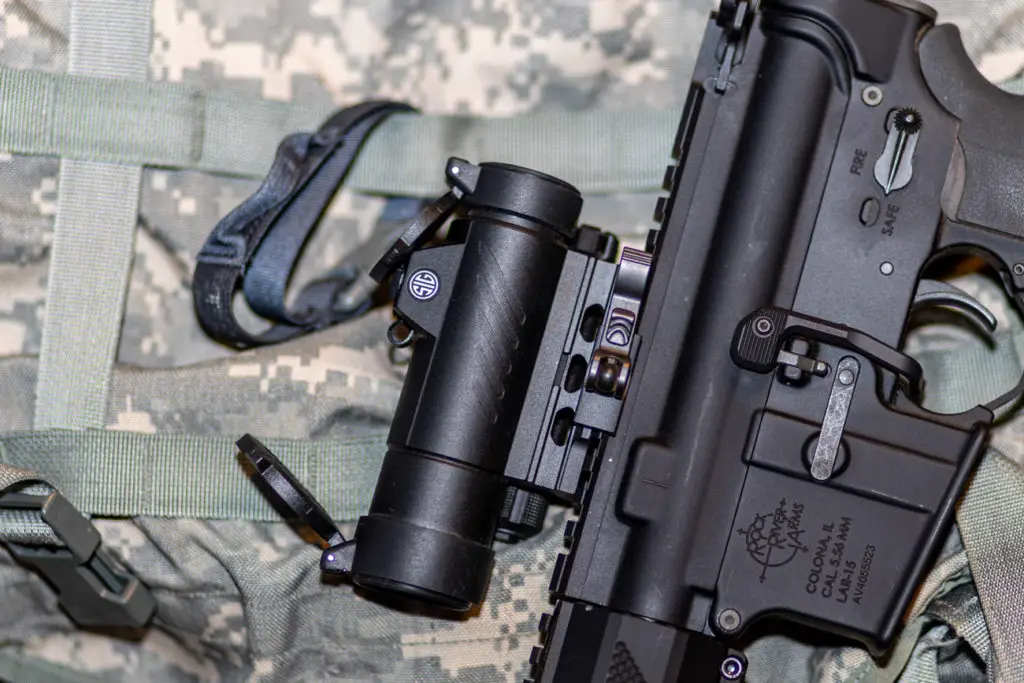
Sighting In
While we are on the topic of sighting in, the first time I shot this Romeo 7 set up, it was typical Minnesota winter. Insanely cold, and deep snow made going to the range out of the question. I went to a friend’s field and with a target grid taped to a box, I trudged through knee to drifted up waist deep snow to set up and shoot. On white paper, the small 5.56 holes were difficult to see with naked eye or the optic and I decided to shoot one and adjust and go from there. It was too cold to waste time.
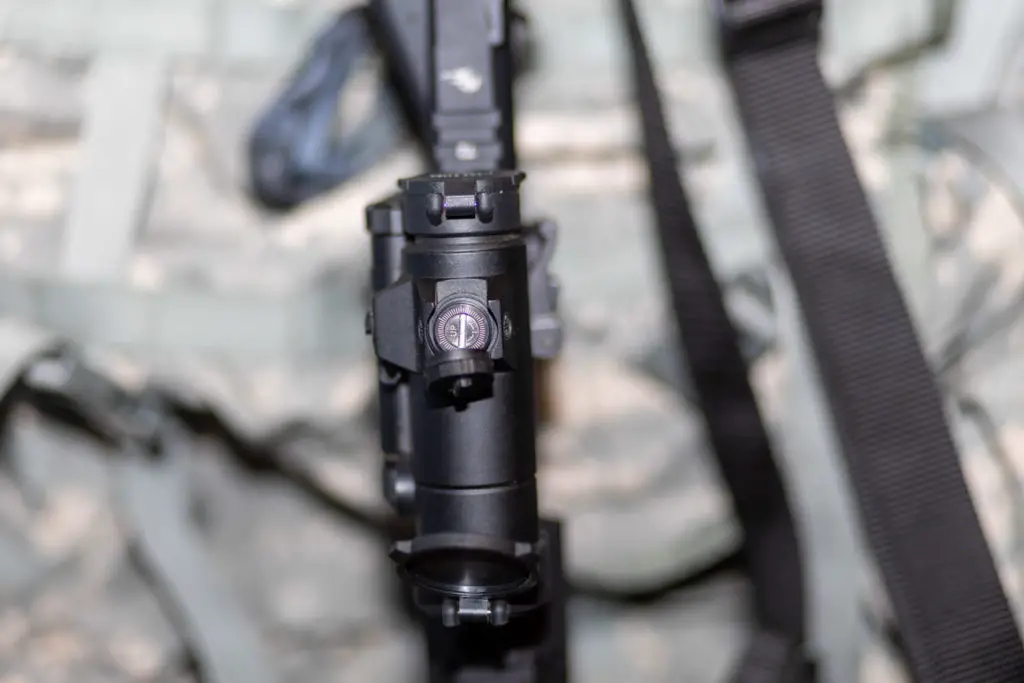
When I went to adjust, I found my only real complaint about the optic. The caps on the adjustment turrets seem to be threaded for a mile. Twisting them off to get to the turret seemingly takes forever and as flush as they sit in the optic, doing it with gloves on or with bare skin in cold temperatures is zero fun. To make matters worse, I had nothing to insert into the slot of the turret to make the adjustments and the truck was 100 yards away. I didn’t realize at the time, but the scope caps have a lip to not just help you unscrew them, but to flip over and insert into the turret to adjust. This is well thought out, simple and effective. If only I would have put two and two together that day!
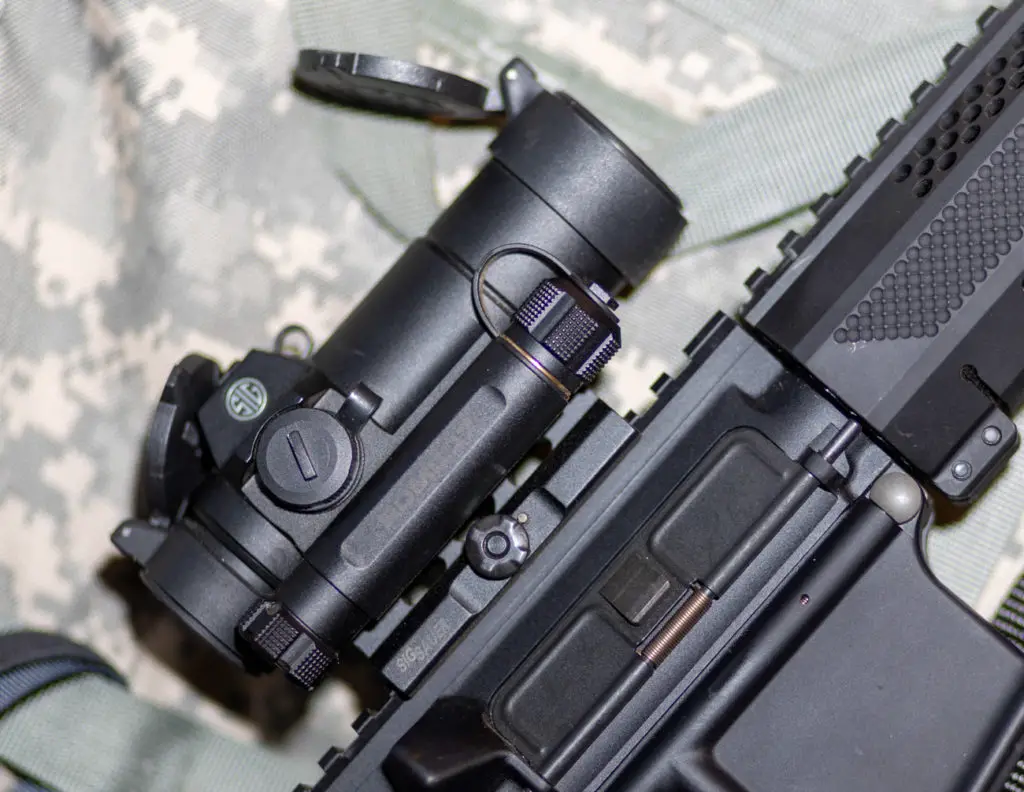
Still, my comment on these caps is valid. The cap is tethered to the turret and between that and the cap itself and how it is seated into the optic, it is not easy to get off for adjustments. The very thick aluminum wings that protrude up the sides housing the turrets are perfect for protection and do their job in that regard well, but the same thing that protects the turret is the thing that makes it difficult to adjust. However, normal people don’t sight in a rifle in temperatures cold enough to hurt in. And… once it is sighted in, and you don’t have a need to remove the caps, so who cares? So, my complaint though has merit, it really isn’t that big of a deal. Still, this could easily be rectified by allowing a little more of a gap between turret and the aluminum protecting the turret, and the cap not being tethered. Just trust me when I say you are not taking those caps off while wearing gloves.
I am not gentle on gear. If it isn’t up to the task, it isn’t going in the safe and it surely is not something I would be willing to keep around as a personal defense tool. While I have no intentions of purposely dropping it on cement or frozen ground for the sake of testing, warranty or not, I am unintentionally brutal on my hunting and shooting gear. To date, my Romeo 7 has been banged off the frozen ground, the side of my truck, the tailgate, countless field gates, shooting benches, the floor in the cab of the truck and trees at temperatures the average reader wouldn’t find believable. Not only has it not so much as blinked, but it has also held zero flawlessly. While basic combat accuracy doesn’t perhaps require such nit picking, shooting smaller targets like coyotes, fox, and wild boar does.
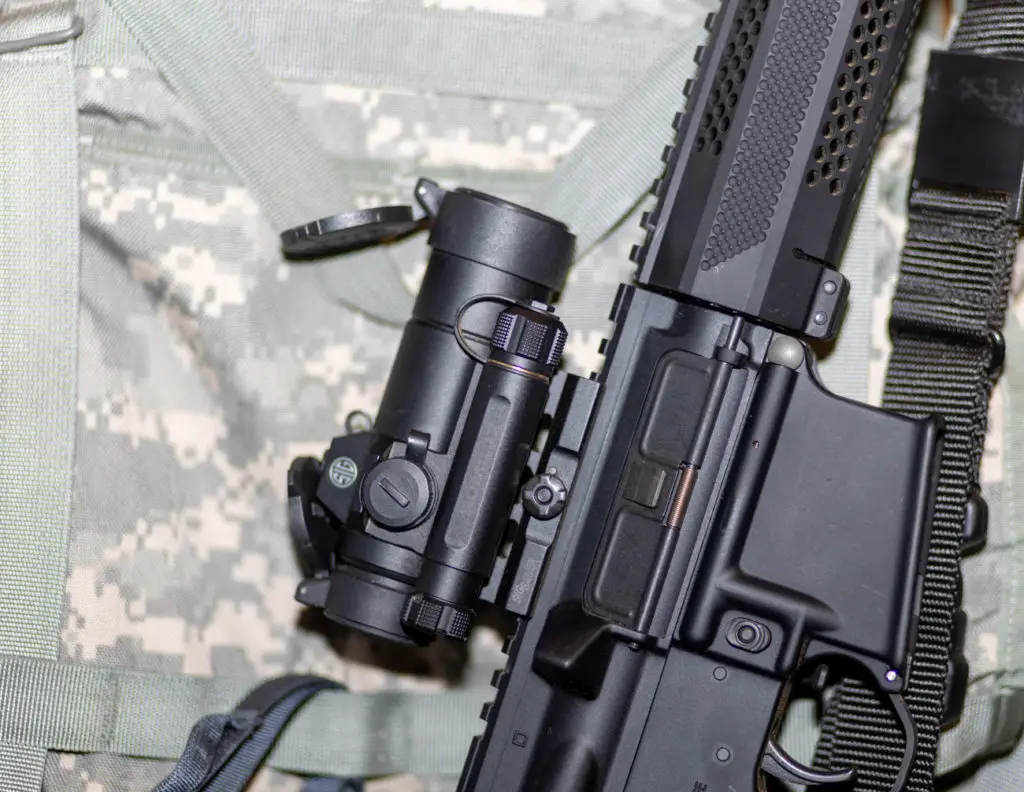
Shooting smaller steel plates or cardboard surely requires an optic durable enough to withstand a bit of a beating and maintain zero. Is this my first choice in a predator hunting set up? No. Living on the edge of the prairie pothole region means lots of open fields, frozen sloughs, potholes, and lakes, and all of these mean the potential of a much longer precision shot.
Occasionally we do hunt wooded areas or pocket openings where targets seemingly pop out of nowhere and disappear as quickly, and that is where for hunters, something like this or to be fair an LPVO shines. Where the Romeo shines in comparison to an LPVO though is the dot itself and in most cases cost. If the LPVO isn’t illuminated and with a very simple reticle, then it isn’t a fair side by side comparison at all. This is an optic for speed and in that case, it does its job extremely well.
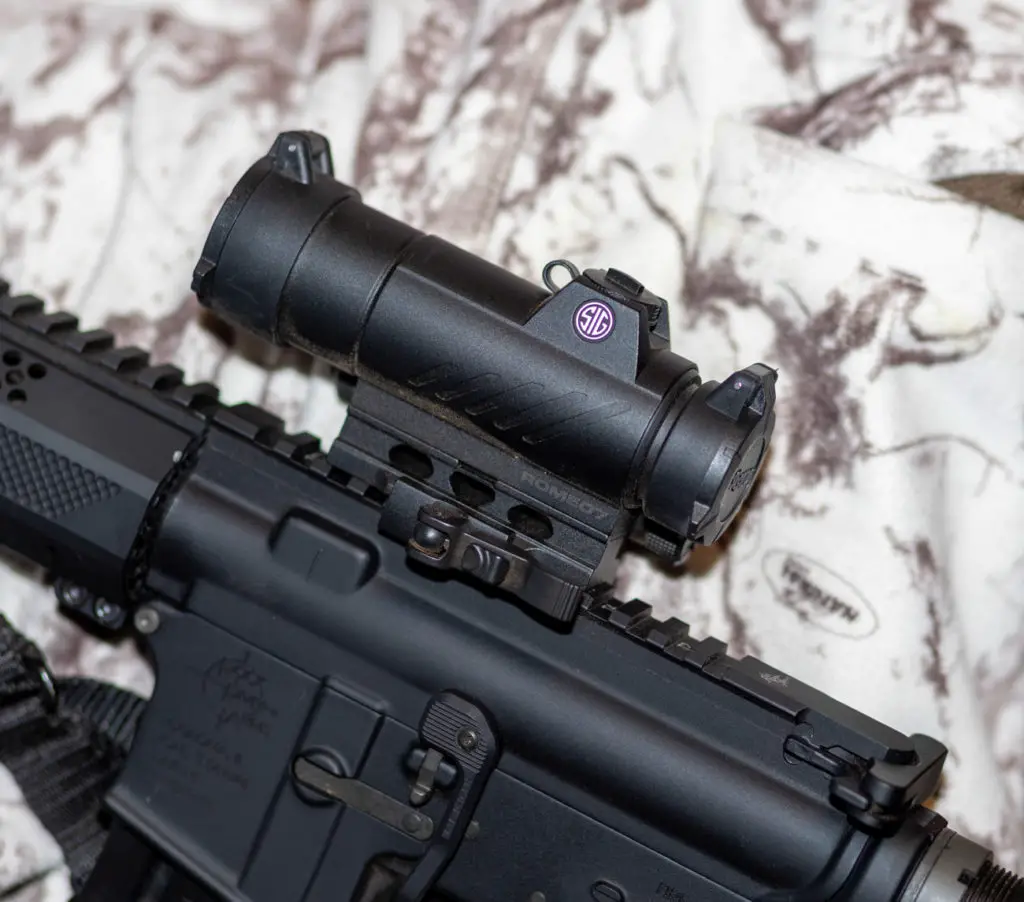
I have shot this set up, hunted with this set up, and frankly all but abused this set up for two seasons now and I get asked the question “Would you buy another?” and the answer is a resounding yes. On the right rifle, like a 16–18-inch barreled AR platform, it is awesome. With a retail price hovering around the $200 mark, it is well worth the cost. I would expect an optic performing this well and this well built to have a much higher retail. While I am still more of a fan of high-powered precision optics and their respective capabilities, I have liked this optic enough to strongly consider throwing both a magnifier on the rifle to extend ranges just for versatility and after seeing how fast target acquisition is with it, putting a Sig reflex site on one of my competition pistol set ups.
Verdict
In closing, I would simply say the Sig Romeo 7 is a great optic at a great value. The fact that it comes with a QD and a low mount, flip open scope caps, and has a lifetime warranty from Sig just seals the deal.
I am used to spending $1K or more on optics and then having to add in a base, and then rings, and then caps and then go to a sporting goods store to try and find a compatible battery…the list seems like it goes on forever and those costs can be all but painful subtractions to the checkbook. This comes ready to go, and at a fraction of the cost of similar optics from competitors.
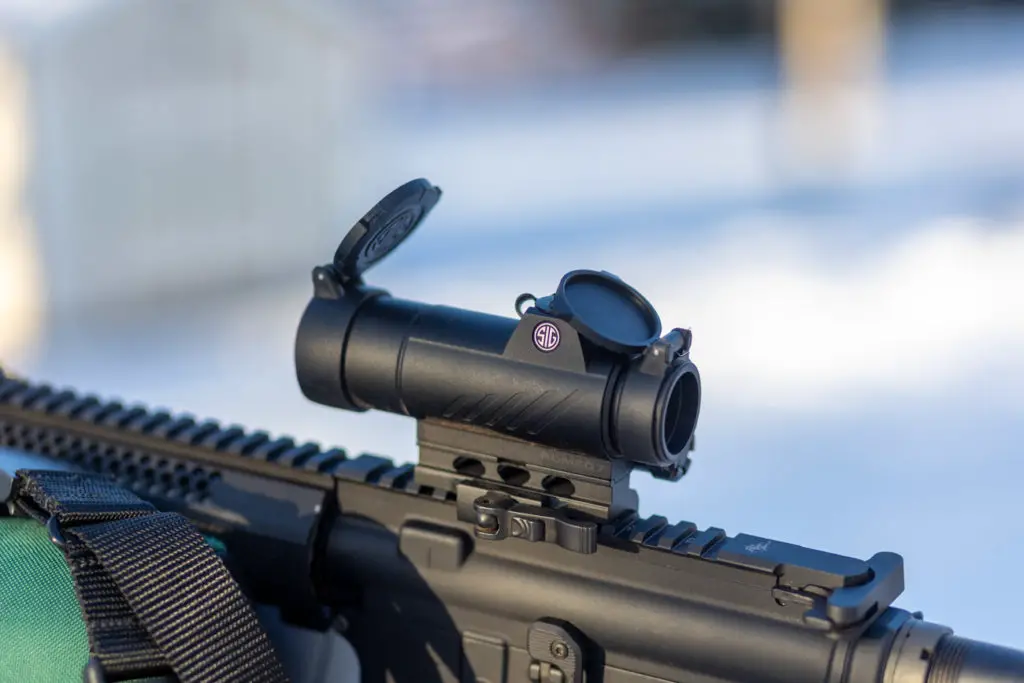
Check Price at:
Also, check out our other reviews on the Sig Romeo 5 and the Sig Romeo 4.

Mark Brendemuehl is a lifelong hunter and shooter of rifles, shotguns and handguns. He competes in defensive pistol leagues and regularly shoots rifle at long range. As a professional photographer, if he isn’t looking through a rifle scope, he is probably looking through a camera lens.
